|
EXAMPLES FOR EXAM I
| If it is not already on your hard drive, you will need to download
the free DPGraph Viewer to view some of
the pictures linked to on this page. |
 |
QuickTime free download. |
 |
Many examples can be found at
Visual Calculus.
Here is a Maple
Worksheet that includes some of the examples below.
This animation
relates to example 5, page 51 in your text, a limit involving sin(1/x) as x approaches 0.
The function f(x) = sin(1/x) has a non-removable discontinuity at x = 0.
Quicktime
version

Here is an animation that zooms in on the
point (1.5,0) in graphically analyzing the following limit:
Quicktime
version

This
animation zooms in on the point (2,2) in graphically analyzing the limit as
x approaches 2 of

Quicktime
version
The function above has a non-removable discontinuity at
x = 2.
This animation zooms in
on the point (1,1) in graphically analyzing the limit as x approaches 1 of

Quicktime
version
The function above has no discontinuities.

See the graph at the right or this zoom
in on the point (0,0). The function
f(x) = xsin(1/x) has a removable discontinuity at x = 0. Click on
the picture to see an animation in which the scale on the y-axis remains
fixed but the interval on the x-axis centered at zero becomes smaller and
smaller. Quicktime
version |
 |
| A Limit By Direct Substitution

The animation at the right is intended to
illustrate graphically the satisfaction of the epsilon/delta
definition of limit for this example.
Large Animation
Click here to look
at another animation relating to Example 8, page 54 in the text and visually
demonstrating the Epsilon-Delta definition of limit. Here is a Quicktime
version of the example 8 animation and a Quicktime
zoom version of the animation.
|
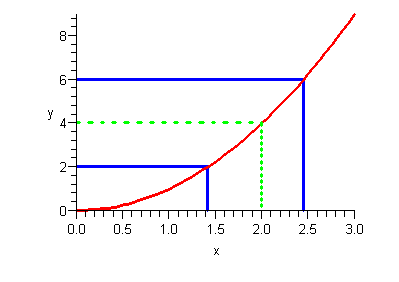 |
Verifying a limit using the epsilon-delta definition
of limit animation
Quicktime Version
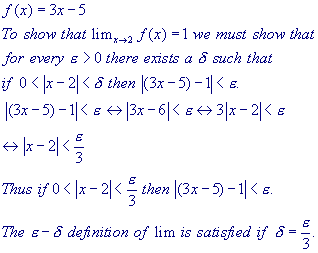
Verifying a limit using the epsilon-delta definition
of limit--non-linear case
Graphically satisfying the epsilon-delta definition
of limit for a given value of epsilon
 |
| Given below is the graph of the
function over the x-interval [1.9,2.1] along with a plot in blue of the
point (2,16) (limit point).
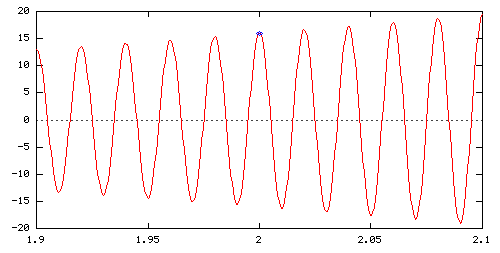
In each of the graphs linked to below the
y-interval is [15.999,16.001], i.e., 16 - epsilon to 16 + epsilon where
epsilon equals 0.001. In some of the graphs the values labeled on
the x-axis have been rounded off. This has led to, for example, the
x value being labeled as 2 at more than one place on the horizontal
axis. For the delta value being used in each picture to satisfy the
definition of limit for the given epsilon value (0.001) the graph must not
"go off the screen" at the top or bottom over the interval being
pictured. On your exam you will be required to find a value for
delta that satisfies the definition of limit and does not produce a
graph of the function that looks almost horizontal over the
delta-interval.
In graph
1 the x-interval is [1.999,2.001], i.e., 2 - delta to 2 + delta where
delta equals 0.001.
In graph
2 the x-interval is [1.9999,2.0001], i.e., 2 - delta to 2 + delta
where delta equals 0.0001.
In graph
3 the x-interval is [1.99999,2.00001], i.e., 2 - delta to 2 + delta
where delta equals 0.00001.
In graph
4 the x-interval is [1.99998,2.00002], i.e., 2 - delta to 2 + delta
where delta equals 0.00002.
Graph
5 is an animation with delta starting at 0.001 as in graph 1 and
approaching 0.
Quicktime
version of the graph 5 animation
We can
observe that a delta value of 0.00002 is close to being as large as delta
can be. We could place a bound on how large delta could be if
epsilon equals 0.001 by solving the equation given below.

In graph
6 delta equals 0.00002069.
Here is a Maple Worksheet investigation. |
Limit
Example--Analytical and Graphical
An
example relating to Theorem 1.2, Properties of limits

Why is the
example below not an exception to Theorem 1.2?

| Special Trig Limits
and the Squeeze Theorem

Click on the picture at the right to see an
animation.
Quicktime
Animation |

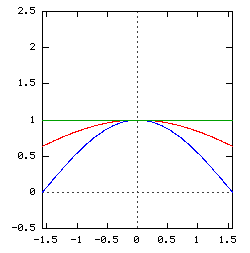
|
Here are some analytical computations of limits.
Click anywhere on each example to see a picture.
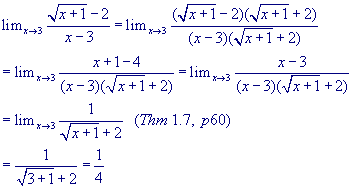
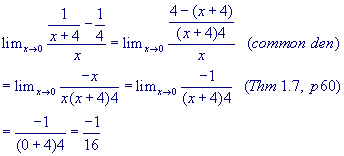
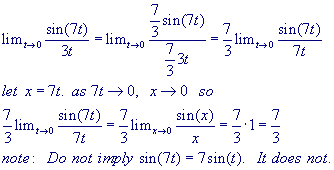
Quicktime Animation

This animation (version2)
shows the graph of the function f(t) above as t goes from 1 to 12.
Quicktime Version

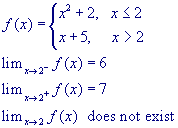
Quicktime
Animation
| Continuity Example
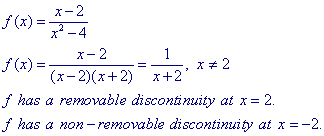
|
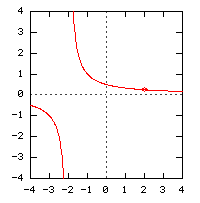 |
| Example Similar To P80: 57-60
The goal is to find the values for a and b that
will cause the function defined at the right to be continuous
everywhere. Due to the nature to the function "pieces", f
must be continuous everywhere except possibly at x = -2 and x = 3.
To be continuous at x = -2 and at x = 3 the "pieces must
connect" at x = -2 and at x = 3. This means that x + 6 must
equal ax2 + b at x = -2 and 6 - x must equal ax2 + b
at x = 3. To find a and b such that these two pieces will
"connect" we must solve a linear system of equations as shown on
the right. The graph of f with a = -1/5 and b = 24/5 is shown below
with each piece of this piecewise defined function shown in a different
color.
Another way of putting this is that we must find
a and b such that

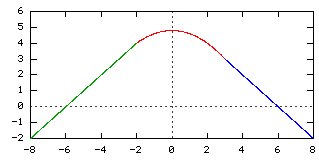
|
 |
| Intermediate Value Theorem Example
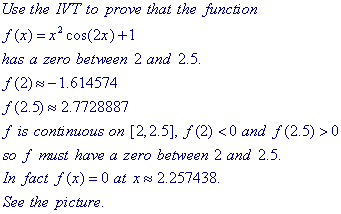
|
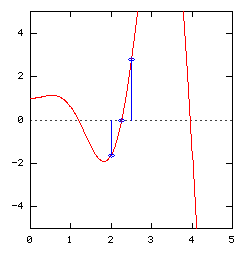 |
| Infinite limit example
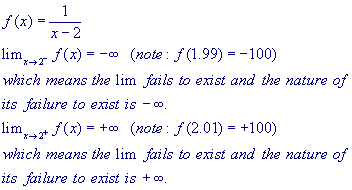
|
 |
return
|

